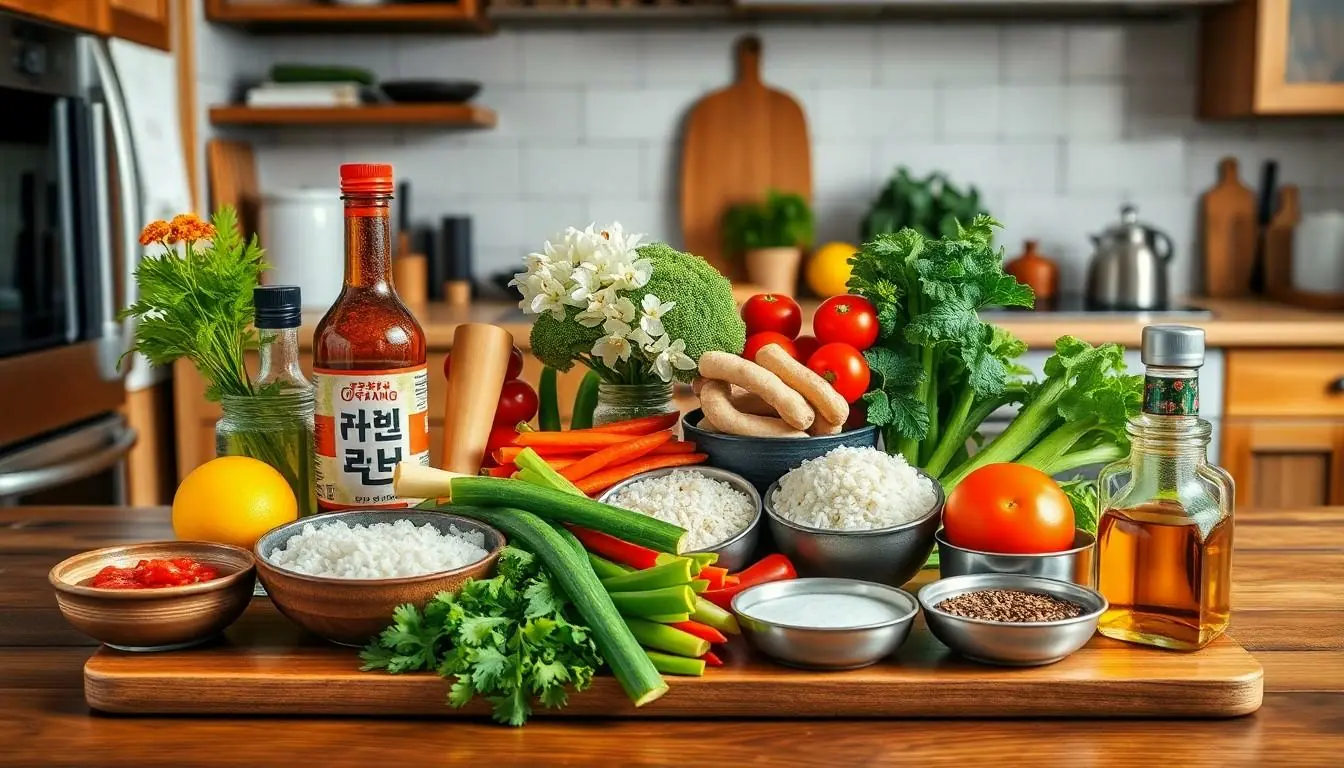Table of Contents
ToggleKorean cuisine has taken the world by storm, and it’s not just because of the K-pop craze. With its bold flavors and comforting dishes, cooking Korean food at home can transform any ordinary dinner into a culinary adventure. Imagine the aroma of sizzling bulgogi wafting through your kitchen or the tantalizing crunch of homemade kimchi. Who wouldn’t want to impress their friends with a feast that could rival a Korean barbecue?
Popular Korean Dishes to Make at Home
Bulgogi stands out as a favorite. This marinated beef dish features a sweet and savory glaze, grilling to perfection enhances its flavor.
Kimchi adds a tangy kick to any meal. Fermented vegetables, usually napa cabbage and radishes, provide a probiotic-rich side that complements various dishes.
Japchae serves as a delightful noodle dish. Sweet potato starch noodles stir-fried with an assortment of vegetables and beef create a colorful and nutritious meal.
Tteokbokki hits the spot for those craving something spicy. Chewy rice cakes simmer in a gochujang sauce, resulting in a comforting and satisfying street food option.
Bibimbap brings diversity to the table. This bowl features a mix of rice, fresh vegetables, and a fried egg, often topped with spicy gochujang for added flavor.
Korean fried chicken has gained immense popularity. Its crispy skin and succulent meat, often coated in sweet and spicy sauces, make it irresistible.
Sundubu jjigae showcases the heartiness of Korean stews. Silken tofu, vegetables, and seafood or meat simmer together, offering warmth and depth of flavor.
Galbi ribs offer a delightful option for grilling enthusiasts. Marinated short ribs bring tender meat and a rich flavor that pairs perfectly with a side of rice.
Preparing these dishes at home allows an exploration of Korean flavors. Each recipe brings a unique experience and can be enjoyed with family or friends.
Essential Ingredients for Korean Cooking

Cooking Korean dishes requires specific ingredients that bring authenticity to flavors. Understanding these essentials elevates the cooking experience.
Common Staples
Rice serves as the foundation for many meals and is often paired with various side dishes. Noodles, particularly sweet potato or wheat noodles, feature prominently in dishes like japchae. Fresh vegetables, including napa cabbage, green onions, and garlic, are integral in enhancing the flavors of any dish. Tofu adds protein and texture to stews and stir-fries. Finally, sesame oil contributes a distinctive nutty aroma that enhances multiple recipes.
Unique Korean Seasonings
Gochujang, a fermented chili paste, provides a delightful heat for many dishes. Soy sauce, essential in marinating meats, brings a savory depth to Korean cuisine. Doenjang, fermented soybean paste, offers a rich umami flavor, often found in stews. Sugar balances savory elements in various marinades, creating complex flavors. Lastly, sesame seeds add crunch and visual appeal to finished dishes, making them more enticing.
Step-by-Step Recipes
Explore these popular Korean dishes that are simple to make at home. Each recipe highlights unique flavors and techniques, perfect for any culinary enthusiast.
Bibimbap
Bibimbap combines various ingredients for a colorful, nutritious meal. Start with cooked rice as the base, then layer sautéed vegetables like zucchini, carrots, and spinach on top. Add a fried egg in the center for richness. Drizzle gochujang over everything for that signature spiciness. Mix it all together before serving to blend the flavors harmoniously. Customize the dish by adding protein such as bulgogi or tofu for an extra punch.
Kimchi
Kimchi features fermented vegetables with a bold, tangy flavor that’s iconic in Korean cuisine. Begin by salting napa cabbage to draw out moisture, then rinse and drain thoroughly. Mix chili powder, garlic, ginger, sugar, and fish sauce to create the spicy paste. Coat the cabbage and other vegetables like radishes in this mixture. Pack everything tightly in a jar, letting it ferment at room temperature for a couple of days before refrigerating. Enjoy the complex flavors that develop over time as a side dish or as an ingredient in other recipes.
Bulgogi
Bulgogi offers a deliciously sweet and savory taste with marinated beef. Slice tender beef into thin strips for optimal flavor absorption. Combine soy sauce, sugar, sesame oil, garlic, and pepper for the marinade, ensuring an even coating on the meat. Allow it to marinate for at least 30 minutes, but overnight deepens the flavor. When ready to cook, stir-fry the beef quickly in a hot pan until caramelized. Serve bulgogi with rice and your choice of side dishes for a satisfying meal that’s sure to impress.
Tips for Cooking Korean Cuisine at Home
Cooking Korean cuisine at home involves understanding key tools and techniques. Employing the right kitchen equipment enhances efficiency in preparing authentic dishes.
Kitchen Tools and Equipment
Essential tools for Korean cooking include a large mixing bowl, a heavy skillet or wok, and a rice cooker. A mandoline slicer aids in finely cutting vegetables, while a wooden spoon works well for mixing ingredients. A mortar and pestle facilitates grinding spices, enhancing flavor. Cast iron grills prove invaluable for meats like bulgogi. For those who enjoy fermented dishes, a fermentation jar becomes crucial for successful kimchi preparation. Collecting these tools simplifies the cooking process and ensures precision in every dish.
Cooking Techniques
Mastering specific techniques elevates Korean cooking skills. Start with marinating proteins in flavorful mixtures, allowing the ingredients to soak overnight for optimal taste. Stir-frying requires high heat to achieve the signature crispy texture found in dishes like Korean fried chicken. Achieving the perfect balance of seasoning involves tasting frequently during cooking. Simmering broths for stews like sundubu jjigae deepens flavors and allows for ingredient melding. Finally, the art of plating enhances presentation, making each dish visually appealing while emphasizing the fresh components involved.
Exploring Korean cuisine at home opens up a world of bold flavors and comforting meals. With a variety of dishes to try from bulgogi to kimchi each recipe offers a unique culinary adventure. The essential ingredients and techniques discussed empower home cooks to recreate these beloved flavors effortlessly.
Whether it’s a casual dinner or a special occasion these dishes are sure to impress. Embracing the art of Korean cooking not only enhances one’s culinary skills but also brings friends and family together around the table. So why not dive into the vibrant world of Korean cuisine and create memorable meals that celebrate its rich heritage?




